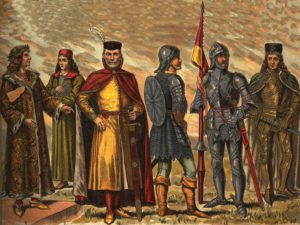Báthory István defeats the Ottomans at Illádia, 12 October 1512

Selim (later nicknamed “the Terrible”) deposed his more peaceful father, Sultan Bajezid II, from the throne of the Ottoman Empire in April 1512. Bajezid died shortly thereafter, and his son began a more aggressive expansion of the empire. Sultan Selim focused more on the eastern lands, but he also tried to test the strength of the Kingdom of Hungary. This happened 22 years after the death of King Matthias Corvinus and 14 years before the Battle of Mohács. Let us remember that the Hungarian Kingdom was still the biggest rival of the Ottoman conquest of the West, a roadblock before Vienna and Rome.

In the time of King Matthias Corvinus, the Ottoman Empire was much smaller than it had been during the reign of King Lajos (Louis) II. In fact, it was half the size in Matthias’ time, while the economic power of the Ottomans was only about a third of what it had been in Selim’s time. After the death of Matthias, the Jagiellonian kings spent the kingdom’s money on the welfare of the country, and the mighty Black Army, Europe’s first standing army, was disbanded.

In 1512, the military strength of Hungary was just enough to withstand the combined military power of the Ottoman sanjaks and vilayets on the other side of the border. Not to mention the rapid development of the quality of the Ottoman army, which became better and more up-to-date than the armies of contemporary Europe. Its training, equipment, artillery, and logistics were far ahead of the Western armies by the end of the 15 Years’ War in 1606. Here is more about the Long War aka the 15-Year-War (1591/93-1606):
The difference in effectiveness between the western and eastern warfare became seriously visible only after the Thirty Years’ War (1618-1648), but as for 1512, the Ottomans were still in a better situation. Knowing this, the Hungarian Borderland warriors faced a real threat when the Ottoman armies attacked the southern line of fortresses in October 1512. The enemy attacked from several directions, trying to split the Hungarian southern defense system. Although one of the Ottoman armies was defeated, they managed to isolate the Hungarian armies from each other.

The Bosnian Turkish troops managed to hinder the army of Palatine Perényi Imre in Slavonia. Another Ottoman army attacked the Temesköz, a flat region bordered by the Tisza, Maros, and Danube rivers and divided by the Temes River, located in present-day Hungary, Serbia, and Romania. Meanwhile, the main Ottoman army successfully conquered the Banate of Szrebernik, which had been part of Hungary since 1404. It was famous for its rich silver mines. After taking it, the enemy also took the castles of Tessány and Szokol. It was possible because the Hungarian units were isolated in the Temes Banate, in the Croatian-Slavonian Banate, and the army of Szapolyai János, Voivode of Transylvania, could not come to interfere either.

However, Duke Báthory István, Comes of Temes County was able to defeat the Ottoman army that was attacking him. His victory took place in Illádia. According to the records of Budai Kakas János, prebend of Pécs, the Ottoman army numbered 3,000 men. According to the report of the Venetian envoy in November, there were 7,000 Turkish soldiers. They attacked the Banate of Temes in the first days of October, as we can read in a valuable source, in the report called “Landorfejírvár veszísinek oka” (“The Cause of the Fall of Belgrade”), written in Hungarian. (Please note that when I write down Hungarian names, I use the oriental order of names, with the surname coming first).
The raiding parties of the enemy came from the castle of Szendrő (Смедерево / Smederevo), which was a neighboring fortress on the Turkish borderland. They crossed the Krassó River and plundered the area of Mezősomlyó (Șemlacu Mare, Großschemlakand) and destroyed the land around Temesvár (Timisoara). They took a huge booty. It is assumed that Báthory István, Count of Temes (later Palatine of the Kingdom) was not there at that time, because he attacked the enemy from the direction of Nándorfehérvár aka Belgrade. Before he arrived there, the defense might have been organized by his subordinates Gétyey János and Kutasy Lukács.

The Hungarian army was much smaller than the Ottomans, but the enemy was burdened with booty and moved slowly. Báthory managed to surprise them and scatter them in Illádia. Báthory collected 160 heads of the enemy and piled them on a big wagon drawn by 8 horses and sent it to the king in Buda together with some prisoners. It was undoubtedly a nice victory, but it could not beautify the loss of the Banate of Szrebernik. The Ottomans were able to make a gap in the southern Borderland system and thus they could reach the Száva River. Let us note that all this was achieved by the combined Ottoman forces of the Borderland region, the main Imperial Ottoman army was not involved.

On May 17, 1526, King Lajos II issued a document praising the military deeds of Perneszy Ferenc. According to this, the young nobleman fought at Illádia in 1512 when he was only 16 years old. Perneszy literally grew up on the battlefields of the Borderland, and at Illádia he fought more bravely than any other adult. He was wounded in the right hand. Later he fought in the Borderland and was one of the brave but few defenders of Belgrade / Nándorfehérvár in 1521. The enemy captured him alive and even the Sultan wanted to see him. According to the legend, he was released because of his bravery. However, we know that the survivors of the siege were slaughtered by the Ottomans, so this legend is quite unlikely. (But the question remains, how could King Lajos have decorated him in 1526 if Perneszy was not alive?)

The defeat at Illádia was a sign that Hungary’s military potential could not be ignored. The Turks also failed to take Jajca Castle in late 1512. The following year, the Ottoman failure at Dubica convinced Sultan Selim that the Kingdom of Hungary was not as weak as he had thought. He realized that he should stop his western expansion for the time being and concentrate on his eastern wars. There were no major attacks against Hungary until 1521. Sultan Selim was satisfied with the conquest of Siria, Mesopotamia, Hedzsász, and Egypt. It was his son, Sultan Suleiman, who would destroy the southern defensive line of Hungary.

As for the illustrations in this article, they were made by Nemes Mihály in 1900, based on figures found on different Hungarian Coat of Arms, tombstones, and paintings. You can find more of them on the page of @Arcanum Adatbázis Kiadó:
Sources: Szibler Gábor, Kiss Csaba, Papp Gergely

Dear Readers, I can only make this content available through small donations or by selling my books or T-shirts.
If you like my writings, please feel free to support me with a coffee here:
You can check out my books on Amazon or Draft2Digital, they are available in hardcover, paperback, or ebook:
https://www.amazon.com/dp/198020490X
or at https://books2read.com/b/boYd81


My work can also be followed and supported on Patreon: Become a Patron!http://Become a Patron!


https://hungarianottomanwars.myspreadshop.com/all


